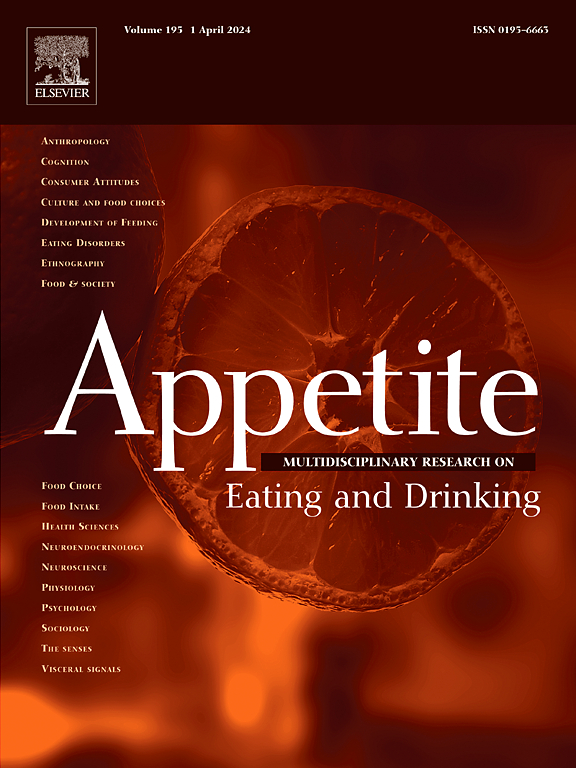A systematic review and meta-analysis of cross-sectional questionnaire studies of the relationship between negative and positive emotional eating and body mass index: Valence matters
IF 4.6
2区 医学
Q1 BEHAVIORAL SCIENCES
引用次数: 0
Abstract
Questionnaire measures of negative emotional eating (NEE) have been associated with elevated body mass index (BMI). Relatively fewer studies have examined positive emotional eating (PEE) and they report that PEE is associated with lower BMI or is not associated with BMI. To examine whether NEE and PEE are linked to BMI, we conducted a systematic review and meta-analysis of studies that used the Emotional Appetite Questionnaire (EMAQ) and the Salzburg Emotional Eating Scale (SEES), which assess change in eating associated with positive and negative emotions, and measured BMI in adults with a range of BMIs. A search of databases (CINAHL Medline, and PsycINFO), citations (Google Scholar) and dissertations (Proquest), and a preprint registry (Open Science Framework, OSF) was conducted independently by three screeners. Forty-three cross-sectional studies were eligible for inclusion. Correlations between BMI and NEE scales and PEE scales were extracted. Age and sex were examined as potential moderators. We found statistically significant (ps < .001) and small mean effect sizes with random-effects models. Higher EMAQ NEE (d = .152 [.11, .19], N = 18,576) and SEES NEE scales (sadness, d = .209 [.168, .250]; angry, d = .096 [.047, .144]; anxiety, d = .169 [.124, .211], N = 4141) were associated with higher BMI. The EMAQ PEE (d = −.073 [-.106, −.041], N = 18,806) and the SEES happy (d = −.157 [-.100, −.114], N = 4141) scales were associated with lower BMI. There was significant heterogeneity in effect sizes for PEE and NEE; however, there was no statistically significant moderation by age or sex. There was also no evidence for publication bias except for SEES sadness. This analysis is limited to cross-sectional questionnaire-based studies. NEE may be associated more strongly than PEE with emotional regulation difficulties and overeating of energy-dense foods which may be why it is associated with higher BMI.
消极情绪进食与积极情绪进食与体重指数关系横断面问卷研究的系统回顾与元分析:效价因素。
负面情绪饮食(NEE)的问卷测量与身体质量指数(BMI)升高有关。相对较少的研究调查了积极情绪饮食(PEE),这些研究报告PEE与较低的BMI有关或与BMI无关。为了研究NEE和PEE是否与BMI相关,我们对使用情绪食欲问卷(EMAQ)和萨尔茨堡情绪饮食量表(SEES)的研究进行了系统回顾和荟萃分析,该量表评估了与积极和消极情绪相关的饮食变化,并测量了具有一系列BMI的成年人的BMI。检索数据库(CINAHL Medline和PsycINFO)、引文(b谷歌Scholar)和论文(Proquest)以及预印本注册表(Open Science Framework, OSF)由三位筛选者独立进行。43项横断面研究符合纳入条件。提取BMI与NEE量表和PEE量表的相关性。年龄和性别被认为是潜在的调节因素。我们发现统计学意义显著(ps
本文章由计算机程序翻译,如有差异,请以英文原文为准。
求助全文
约1分钟内获得全文
求助全文
来源期刊

Appetite
医学-行为科学
CiteScore
9.10
自引率
11.10%
发文量
566
审稿时长
13.4 weeks
期刊介绍:
Appetite is an international research journal specializing in cultural, social, psychological, sensory and physiological influences on the selection and intake of foods and drinks. It covers normal and disordered eating and drinking and welcomes studies of both human and non-human animal behaviour toward food. Appetite publishes research reports, reviews and commentaries. Thematic special issues appear regularly. From time to time the journal carries abstracts from professional meetings. Submissions to Appetite are expected to be based primarily on observations directly related to the selection and intake of foods and drinks; papers that are primarily focused on topics such as nutrition or obesity will not be considered unless they specifically make a novel scientific contribution to the understanding of appetite in line with the journal's aims and scope.
 求助内容:
求助内容: 应助结果提醒方式:
应助结果提醒方式:


